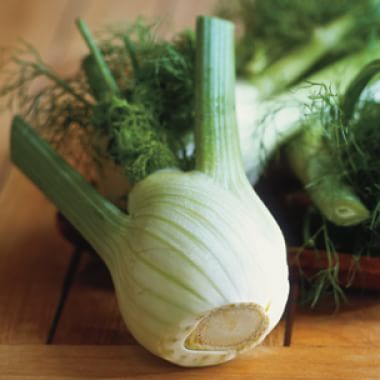
Fennel's leaves, seeds and stems all have a sweet, faintly aniselike flavor. The stems of fennel swell and overlap at the base of the plant to form a bulb with white to pale green ribbed layers that are similar to celery in appearance and texture. Light and feathery, the pretty green leaves slightly resemble fresh dill. Use them as a bed for steaming fish or in small amounts as a garnish.
Originating in the Mediterranean, the fennel bulb appears often in Italian and Scandinavian cuisines. It can be eaten raw or grilled, baked, braised or sautéed. While grilling, you can toss a handful of dried or fresh fennel stems onto the charcoal to infuse meat or fish with a light anise flavor.
Selecting
Choose fresh fennel bulbs that are smooth and tightly layered with no cracks or bruises. Fat, rounded bulbs with white and pale green color will tend to be more succulent than thin or yellow ones. Avoid any with wilted leaves or dried layers. Now available year-round, fennel is at its peak from late fall through winter. Grocers sometimes incorrectly label fennel as "sweet anise."
Storing
Keep fennel bulbs in a perforated plastic bag in the refrigerator for up to 5 days. If kept too long, they will lose their flavor and toughen.
Preparing
Remove the green stems and leaves, saving them to flavor or garnish other dishes such as soups or fish. Discard the outer layer of the bulb if it is tough and cut away any discolored areas. Cut the bulb in half lengthwise and remove the base of the core if it is thick and solid. Gently separate the layers with your hands and rinse well to remove any grit between them. Slice or cut as directed in a recipe.
Adapted from Williams-Sonoma Kitchen Companion: The A to Z Guide to Everyday Cooking, Equipment and Ingredients (Time-Life Books, 2000)
Related Recipes:
- Chilled Potato-Leek Soup with Fennel and Watercress (Vichyssoise) →
- Mushrooms and Fennel with Parmesan Crisps →
- Apple and Fennel Slaw →
- Cannellini Bean, Fennel and Shrimp Salad →
- Whole Striped Bass with Fennel and Tomato →
- Pork Chops with Fennel →
- Braised Fennel with Olive Oil and Garlic →
- Sausage, Fennel and Leek Puff →








